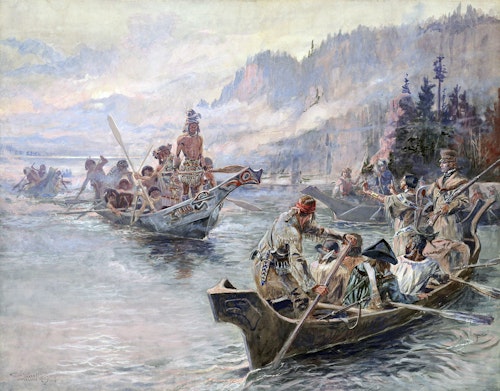Millennials: Think you have it tough? When your Wi-Fi goes out for half-a-day, when your favorite watering hole bumps happy hour drink prices to pay for that new “living wage,” when the organic grocer runs out of arugula from California, wonder how you’ll survive? Look at a fast food joint and swear, “I wouldn’t eat that crap if I were starving to death!”
Well now. When times get “tough,” take solace from the Lewis and Clark Journals. If you paid attention in history class and learned anything about the Corps of Discovery, you might remember that the expedition was led by Meriwether Lewis and William Clark. It was commissioned by President Thomas Jefferson in 1803 to explore the lands west of the Mississippi River that comprised the Louisiana Purchase.
During the trip from Camp Dubois near St. Louis to the Pacific Ocean at the mouth of the Columbia River from May 14, 1804 to September 23, 1806, the 33 men and one dog that started out found things challenging at best – especially when it came to food. The crew was expected to replenish their larder along the way by hunting and gathering as circumstances and conditions allowed. From William Clark’s journal: “It requires 4 deer, or an elk and a deer, or one buffalo to supply us for 24 hours.” Additionally, 193 pounds of “portable soup” were ordered as an emergency ration when stores ran out and game was scarce or unavailable.
The soup was produced by boiling a broth down to a gelatinous consistency, then further drying it until it was rendered quite hard and desiccated. Not exactly a favorite with the men, it nonetheless saved them from near starvation on a number of occasions. Each man consumed 9 pounds of meat per day, when available, and the designated hunters of the Corps were never without work during the entire journey.
Corps member Raymond Darwin Burroughs tallied the quantity of game killed and consumed during the course the expedition thusly:
Deer (all species combined) 1,001; Elk 375; Bison 227; Antelope 62; Bighorn sheep 35; Bears, grizzly 43; Bears, black 23; Beaver (shot or trapped) 113; Otter 16; Geese and Brant 104; Grouse (all species) 46; Turkeys 9; Plovers 48; Wolves (only one eaten) 18; Indian dogs (purchased and consumed) 190; Horses 12.

In addition to this list, the Corps ate countless smaller animals such as hawk, coyote, fox, crow, eagle, gopher, muskrat, seal, whale blubber, turtle, mussels, crab, salmon and trout. It also does not list the many then-unfamiliar varieties of fruits, vegetables, mushrooms, seeds and nuts that were found to be edible. However, all these are mentioned in the journals, oftentimes accompanied by detailed accounts of the adventures associated with their gathering.
The Corps found many different subspecies of deer plentiful across the continent, and venison became a staple throughout the expedition. Bison herds were huge on the Great Plains and, when the Corps crossed the Rocky Mountains, they turned to salmon and wapato (arrowroot), a starchy tuber, as their staples. By necessity, their diet changed according to the changing country over which they traveled, as well as seasonal climatic changes.
Despite all this, without the contribution of local foods by the Indian nations, they Corps may not have survived. For example, the Mandan tribe of North Dakota gave them corn, squash and beans; the Chinooks of Washington’s Columbia River region introduced them to the wapato; and the Clastops along the Oregon brought them elk, wild licorice root and a variety of berries. The Shoshone of Idaho and Montana brought Lewis both antelope and his first-ever salmon, and the Nez Perce tribe of Idaho, Washington and Oregon offered dog as well as edible roots. While encamped at what was named Fort Clatsop at the mouth of the Columbia River, the Corps learned how to extract salt from sea water through evaporation by boiling. It was used both as a seasoning and a vital method of curing and preserving meat, along with smoking and drying.
Despite the abundance of wild foods and the assistance of local tribes, the Corps went hungry on many a night. Hunters missed shots, and there were days when the hunters simply could not find game. Pounding rain sometimes ruined meat that was hung to dry, and heat sometimes spoiled perishables. There are tales of clothing that rotted right off the backs of the men.

One of William Clark’s writings, from September 11, 1804, described the tribulations of the Corps’ youngest member, private George Shannon. Private Shannon is mentioned in several journal entries because he just seemed to get lost often. The first time this happened was on August 27th, 1804, near what is now Yankton, South Dakota. While searching for lost horses, Private Shannon became as lost as the horses and did not find his way back to the company until September 11th. During his time on the prairie, Shannon lived for 12 days on a few wild grapes and a rabbit. It was later discovered that he was traveling ahead of the Corps and, after despairing because he could not catch up with them, he returned downriver towards Saint Louis and eventually found the party.
As Clark wrote:
“He had been 12 days without any thing to eate but Grapes & one rabit, which he killed by shooting a piece of hard Stick in place of a ball. Thus a man had like to have Starved to death in a land of Plenty for the want of Bulits or Something to kill his meat.”
Shannon survived this and other tribulations on the journey. After returning home he studied law and became a lawyer. He was elected a member of the Kentucky House of Representatives in 1820 and 1822 and was a state senator from Missouri for a time before returning to law. He died suddenly in court at Palmyra, Missouri, in 1836, at the age of 49.







